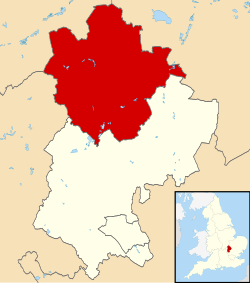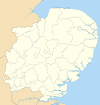Bedford Borough of Bedford | |
|---|---|
| |
 Bedford shown within Bedfordshire | |
| Coordinates: 52°8′0″N0°27′0″W / 52.13333°N 0.45000°W | |
| Sovereign state | |
| Country | |
| Region | East of England |
| Ceremonial county | Bedfordshire |
| Administrative HQ | Borough Hall, Bedford |
| Government | |
| • Type | Unitary Authority |
| • Governing body | Bedford Borough Council |
| • MPs | Richard Fuller (C) Alistair Strathern (L) Mohammad Yasin (L) |
| Area | |
• Total | 476 km2 (184 sq mi) |
| Population (2022) [1] | |
• Total | 187,466 |
| • Rank | 108th |
| • Density | 393/km2 (1,020/sq mi) |
| Ethnicity (2021) | |
| • Ethnic groups | |
| Religion (2021) | |
| • Religion | List
|
| Time zone | GMT |
| • Summer (DST) | British Summer Time |
| ONS code | 00KB |
| NUTS 3 | UKH22 |
| ISO 3166-2 | GB-BDF |
| Website | bedford |
Bedford, or the Borough of Bedford, is a local government district with borough status in the ceremonial county of Bedfordshire, England. It is administered by Bedford Borough Council, a unitary authority. The council is based in Bedford, the borough's namesake and principal settlement, which is the county town of Bedfordshire.
Contents
- History
- Governance
- Parishes
- Freedom of the Borough
- Individuals
- Military Units
- See also
- References
- External links
The Bedford built-up-area is the 71st largest in the United Kingdom and also includes Kempston and Biddenham. [3] Away from the Bedford built-up area the borough includes a large rural area with many villages. 75% of the borough's population live in the Bedford built-up and the five large villages which surround it, which makes up slightly less than 6% of the total land area of the borough.
The borough is also the location of the Wixams new settlement, immediately south of Bedford, which received its first residents in 2009.







